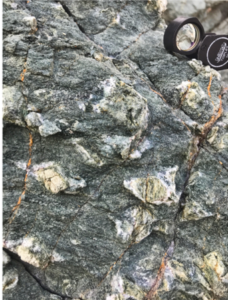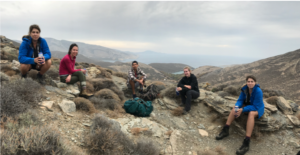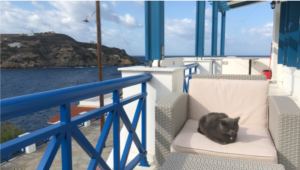In case you didn’t know… Syros represents a fossil subduction shear zone. Rocks were brought to eclogite facies conditions in the Eocene and exhumed through the Miocene, partially along the plate interface and partially by crustal scale low-angle normal faults of the North and West Cycladic Detachment Systems. We go there to study the structural and rheological evolution of several different rock types – oceanic crust and sediments, and bimodal rift volcanics, for example – during subduction and exhumation.
Authored by Alissa Kotowski

All the data I collected in the field this season, which is the source of excitement and a few headaches.
Fieldwork in the fall in Greece is the best. Not only is the weather pretty great, but the islands are relatively free from tourists (and other geologists, for better or for worse). The daily life on the islands seems to move a bit slower, so even though we’re working hard every day (I swear people, it’s work), I feel like it gives me a chance to reset and refocus in the middle of a busy semester. This year, we focused on some big-picture questions about the structural evolution of Syros rocks by collecting a ton of data and looking at fold styles and orientations, mineral and stretching lineations, and associated degrees of metamorphism in the field. And clearly, the structures make a ton of sense as you can see from this beautiful stereonet (just a few headaches were had, as you can imagine). But in all seriousness, we made some awesome progress and I’m really excited to see where all this data is going to take us moving forward.
This was my fourth trip to Syros since I started my Ph.D., and every visit, we manage to find new amazing things in these rocks. Here are some of my favorites from this trip, including gorgeous zoisite porphyroblasts growing in a tensile vein through an eclogite pod, attenuated eclogite lenses and blueschist matrix rocks on the coastline, and lawsonite pseudomorphs with pressure shadows in a greenschist facies shear zone. These rocks are really something special and tell us a lot about the conditions under which these rocks are being deformed during subduction and exhumation. By looking at these features in the field, we can gain an intuition for fluid pressure conditions (near lithostatic!!!) as tensile veins are being mineralized, the relative strengths and deformation styles operating in different metamorphic rock types, and the dynamic, protracted deformational and metamorphic history these rocks have experienced.



This field season gave me lots of new ideas and data to keep me (very) busy as I start to wrap up my dissertation. Thanks to these people for making it a great last trip! And of course, a huge shout out to Kini the cat, who wanted nothing but pets and scratches every night when we got home. But of course we fed her, too.

The crew on the northern part of Syros (Kampos). Whitney Behr, Jaime Barnes, Miguel Cisneros, Alissa Kotowski, and… Whitney again. There was so much to measure that we needed two of her. (PC: Grace Beaudoin)

All of us on Kampos, stoked to find a beautiful little blueschist outcrop!

The super friendly Kini the cat, who came by the house every night to hang out. We seriously considered taking her home.

Until next time, Syros!









